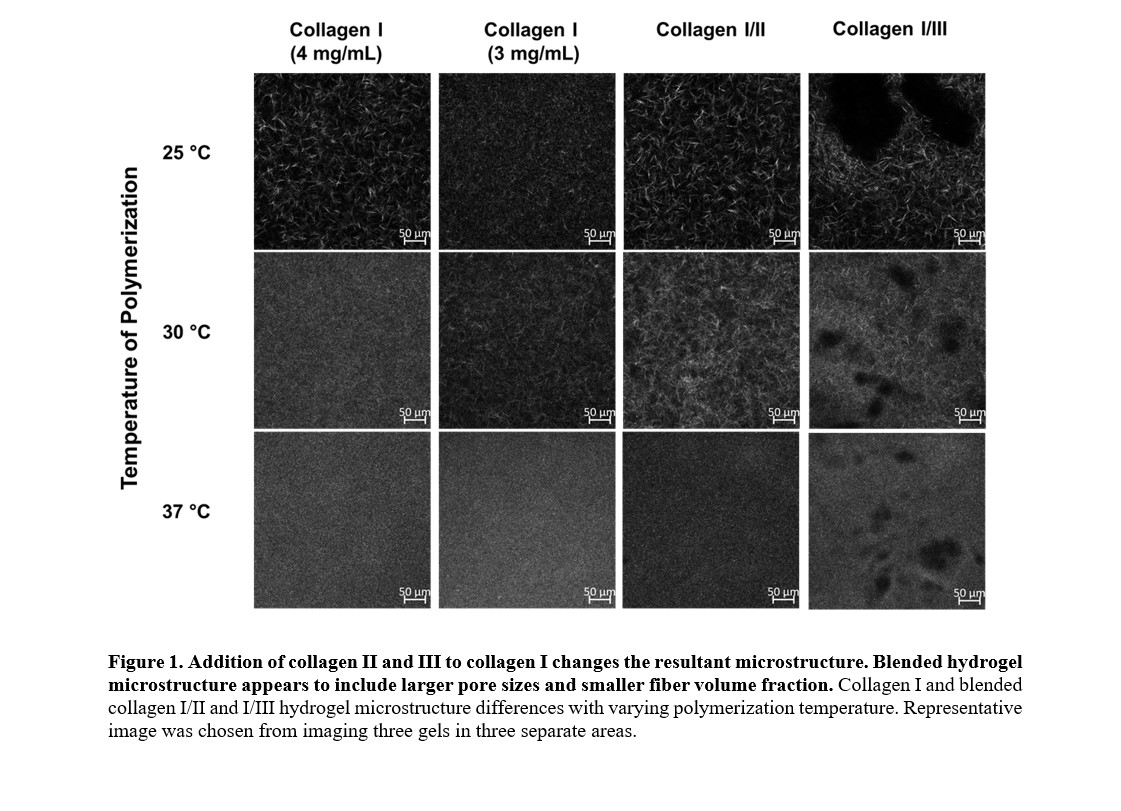2022 Annual Meeting
(405d) Influence of Polymerization Conditions on Collagen I, II, and III Blend Hydrogels
Authors
For this study, total initial col concentration will be held constant at 4 mg/mL, with blended hydrogels composed of 3 mg/mL col I and 1 mg/mL col II or III as this ratio formed robust gels based on previous results in literature.1,2 A control col I hydrogel at 3 mg/mL included as a control. A range of matrix polymerization temperatures (25, 30, and 37 °C) was investigated to capture a large range of fibril formation capabilities of col I and col I/II and I/III blends. Polymerization kinetics show that blended hydrogels polymerize slower compared to pure collagen I gels at both 4 mg/mL and 3 mg/mL. Blended col I/III gels polymerized faster compared to collagen I/II blended gels.4
Blended col hydrogels have altered microstructures (Fig 1), likely resulting from the longer polymerization times. Blended hydrogels appear to have lower volume occupied by fibrils and larger pore sizes for all temperatures tested. Microstructure of control gel (collagen I at 3 mg/mL) is more similar to col I gel at 4 mg/mL compared to the blended hydrogels. Blended collagen I/III hydrogels appeared to have large voids not occupied by fibrils. Those voids form as result of collagen III presence. Preliminary rheological results demonstrate that storage modulus (Gâ) for all gel types were the highest for hydrogels polymerized at 25 °C and lower for both 30 and 37 °C. The results also indicate that the blended hydrogels have lower Gâ compared to collagen I gels. Preliminary assessment of transport properties demonstrates that the addition of col II or III to col I altered the diffusion of dextran through the matrix as observed by Transwell macromolecular recovery studies. Thus, blended col I/II and col I/III hydrogels exhibit properties distinct from pure collagen I gels. Furthermore, properties of blended hydrogels can be tuned by changing the temperature of polymerization.
1Kilmer, C. E. et al. Collagen Type I and II Blend Hydrogel with Autologous Mesenchymal
Stem Cells as a Scaffold for Articular Cartilage Defect Repair. ACS Biomater. Sci. Eng. 6,
3464â3476 (2020).
2Roman, B. et al. A Model for Studying the Biomechanical Effects of Varying Ratios of Collagen Types I and III on Cardiomyocytes. Cardiovasc. Eng. Technol. (2021).
3Yang, Y. L., Leone, L. M. & Kaufman, L. J. Elastic moduli of collagen gels can be predicted from two-dimensional confocal microscopy. Biophysical Journal 97, 2051â2060 (2009).
4Xu, Q. et al. Collagen- and hyaluronic acid-based hydrogels and their biomedical applications. Materials Science and Engineering R: Reports 146, 100641 (2021).
